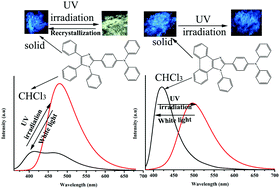Unusual fluorescent photoswitching of imidazole derivatives: the role of molecular conformation and twist angle controlled organic solid state fluorescence†
Abstract
Molecular photoswitching, light induced reversible color/fluorescence modulation, has mostly been realized in organic molecules via E/Z isomerization of azobenzenes and stilbenes and ring opening/closing reactions of spiropyrans and diarylethenes. We report here new fluorescent molecular photoswitches based on triphenylamine (TPA)–imidazole derivatives, N-phenyl-N-(4-(1,4,5-triphenyl-1H-imidazol-2-yl)phenyl)benzenamine (NTPB) and N-phenyl-N-(4-(1-phenyl-1H-phenanthro[9,10-d]imidazol-2-yl)phenyl)benzenamine (NPPB), that exhibited light induced reversible fluorescence switching via conformational change from a twisted molecular structure to more planar. NTPB and NPPB in CHCl3 showed red shift of absorption and fluorescence upon UV light irradiation whereas white light exposure reversed both absorption as well as fluorescence. The role of the TPA–imidazole twisted molecular structure in photoswitching was established based on structure property, computational and photophysical studies. The isobestic point observed in time dependent fluorescence change under UV light irradiation clearly demonstrated the presence of two different conformational isomers. Interestingly, polymorphism and torsion angle (τ) dependent fluorescence of NTPB and NPPB in the solid state also supported the role of the twisted molecular structure of TPA–imidazole in fluorescence switching/tuning. Interestingly, NTPB showed fluorescence photoswitching in the solid state also whereas rigid phenanthrene based NPPB did not show fluorescence photoswitching. Thus the present studies provide structural insight for designing a new type of fluorescent organic molecular photoswitches based on conformational modulation that could be of potential interest in optoelectronic devices.



 Please wait while we load your content...
Please wait while we load your content...